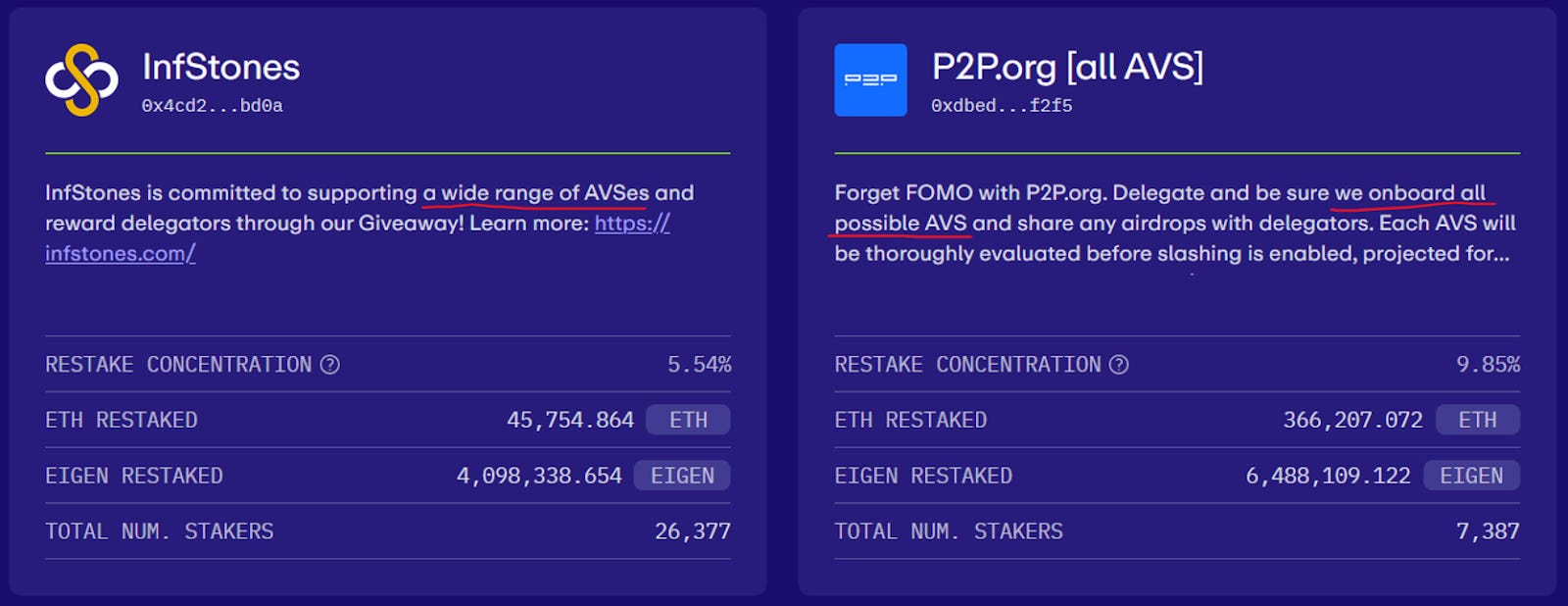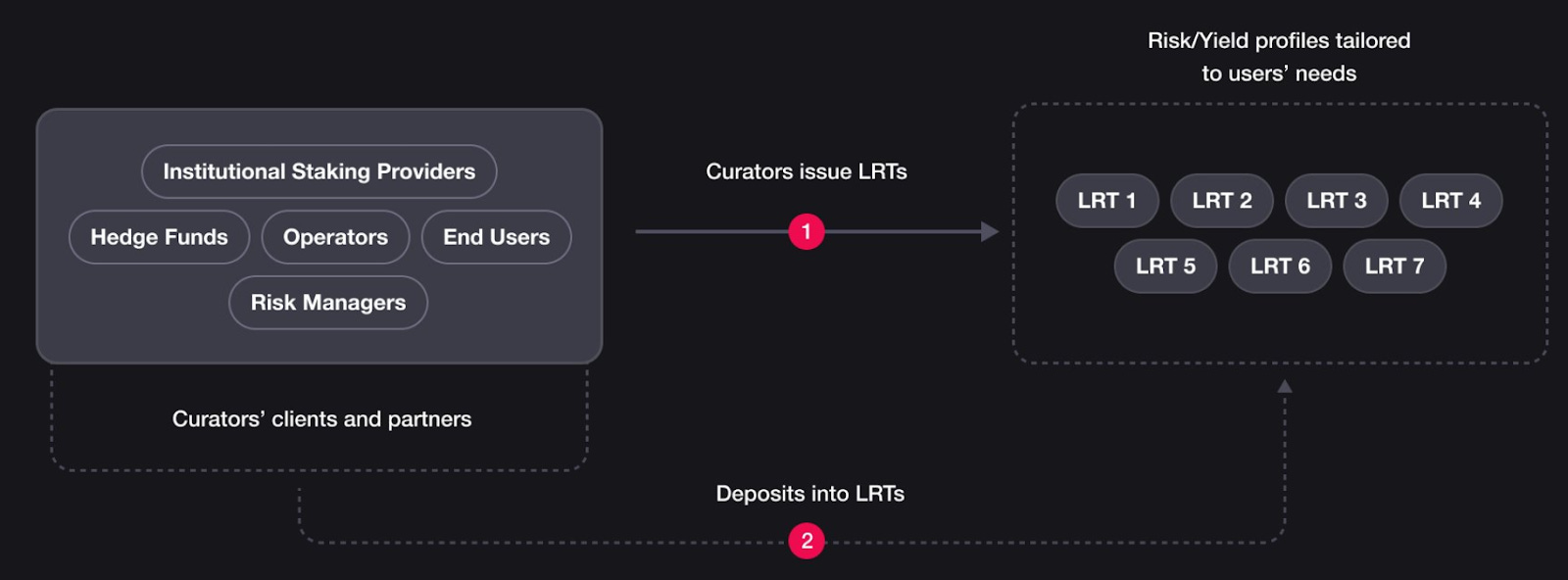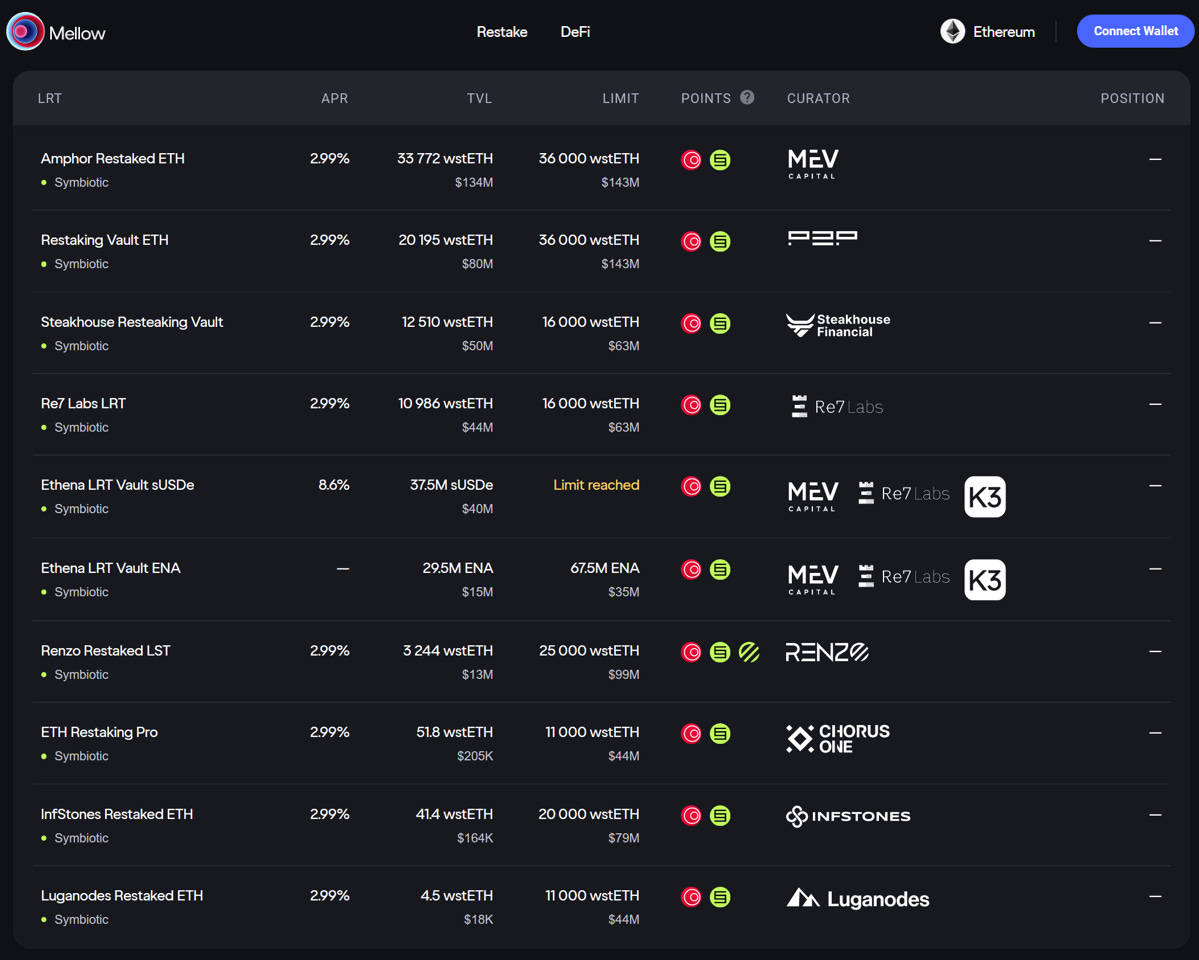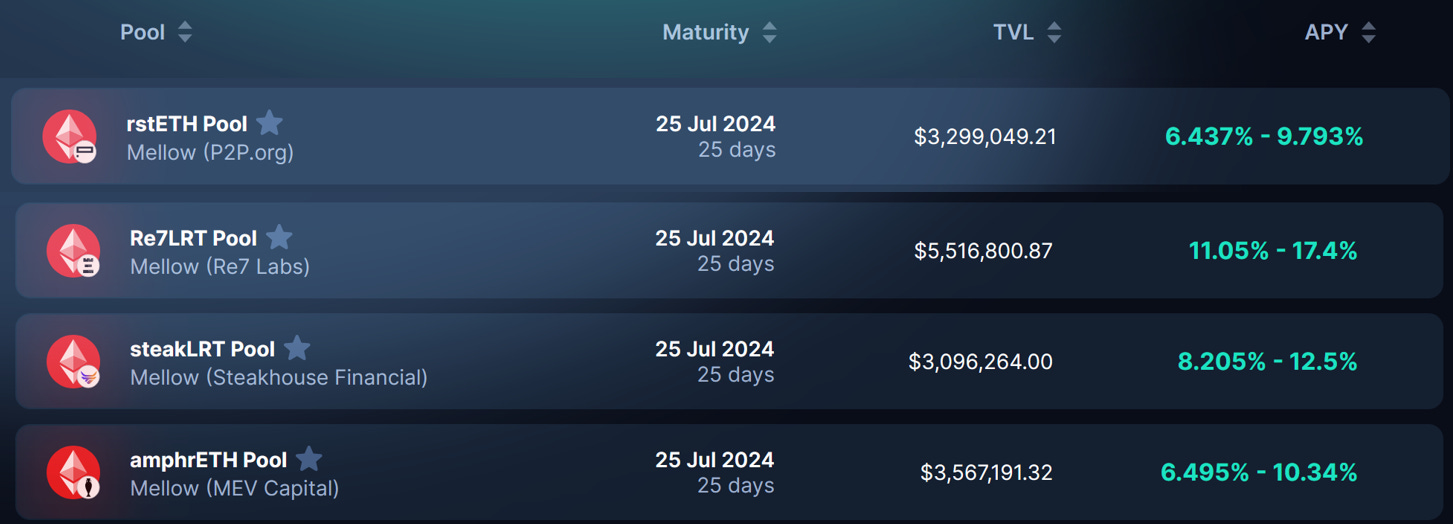The Restaking Wars Are Heating Up
Taking a close look at emerging restaking participants including Symbiotic and Mellow.

Introduction
The restaking wars are heating up. Challenging EigenLayer’s monopoly is yet another new protocol Symbiotic backed by Lido. The latest entrant brings a competitive edge in terms of protocol design and BD partnerships. Before we get into the new competitive dynamics in restaking, we need to first understand critical risks in the existing setup.
Problems with restaking today
Here’s how restaking works today: Bob deposits ETH/stETH into a liquid restaking protocol like Ether.Fi, Renzo or Swell, who then delegates it to an EigenLayer node operator, who then secures one or many AVSs to return some yield to Bob.
There is a compounding risk in this existing setup, and it lies in its one-size-fits-all nature. EigenLayer node operators handle hundreds of thousands in assets that are used to validate multiple AVSs. This means that Bob has no say in the underlying risk management of what AVSs are being selected by node operators.
To be sure, Bob could try and opt for a “safer” node operator, but operators are engaged in a race to the bottom competition against hundreds of other operators that want your restaked collateral and are all incentivized to validate as many AVSs as possible to maximize yield for you.
A quick look at the node operator page on EigenLayer and we can see many such explicit advertisements.

This competitive state of affairs may potentially result in an ugly outcome nobody wants to see happen: every node operator secures an AVS they think is infallible. When that AVS is disrupted and a slashing event occurs, that impacts Bob no matter which operator he chooses from.
Enter Mellow Finance
Mellow solves this (kinda). Also referred to as a “modular LRT”, Mellow is a middleware layer in the restaking stack that offers customizable liquid restaking vaults. With Mellow, anyone can be their very own Ether.Fi or Renzo and launch their own LRT vault. These third-party “curators” on Mellow will have full control over what restaking assets are accepted, which users then choose according to their risk preference and pay a fee to.

Here’s a ridiculous example: Alice is a die-hard DOGE-maxi, and she’s on the hunt for yield from her DOGE bags. She looks on Mellow and sees a vault named DOGE4LYFE. She deposits her DOGE into DOGE4LYFE vault, receives a restaking yield, pays a small fee to the operator, and receives in return a LRT named rstDOGE, which she can then use as collateral elsewhere in DeFi. This is not currently possible because EigenLayer does not whitelist DOGE. Even if Sreeram comes around to DOGE, the aforementioned misaligned incentives that node operators face remains.
If this sounds familiar, it is because a similar service has been offered in DeFi lending with protocols like Morpho, Gearbox or as DeFi veterans from the last cycle might remember, the now-deprecated Fuse protocol by Rari. Morpho, for instance, enables the creation of lending vaults with customized risk parameters. This allows users to borrow assets from a vault with a unique risk profile, rather than a one-risk-size-fits-all pool on Aave. In its upcoming V4 upgrade, Aave is also planning to upgrade the protocol with isolated lending pools.
The Mellow x Symbiotic x Lido strategy
Since Mellow is merely a middleware restaking protocol, its assets in vaults have to be restaked somewhere. Interestingly, Mellow has strategically aligned itself not with EigenLayer, but upcoming restaking protocol Symbiotic, notably backed by Lido’s venture arm cyber•Fund and Paradigm (the latter of which is also a backer of Lido).
Unlike EigenLayer or Karak, Symbiotic features multi-asset deposits of any ERC-20 token, making it by far the most permissionless. Anything from ETH to the most degenerate memecoin can be used as restaking collateral to secure an AVS. This potentially opens the door to the worst excesses of crypto degeneracy: think a Symbiotic AVS secured by a Mellow vault of restaked DOGE collateral.
somebody already tried restaking a milady on symbiotic pic.twitter.com/Bn3T2CnNiw
— Symbiotic (@symbioticfi) July 1, 2024
While all that is technically possible, it misses the point of Mellow’s modular nature of its product, which is to allow an infinite composability of restaking yield as designed by third-party vault curators. Here it becomes clear the rationale for Mellow to integrate with Symbiotic, as assets are still permissioned on other restaking protocols like EigenLayer or Karak.
To date, a slew of curators have onboarded Mellow to open their own LRT vaults. Unsurprisingly, most curators are using stETH as staking collateral given Lido’s heavy involvement with Mellow (more on this later).
The exception are two Ethena’s vaults that accepts sUSDe and ENA. Yes, Mellow has pulled off the impressive feat of onboarding Ethena — its first sUSDe vault has already been filled.

The final piece in the Mellow strategy lies in its participation in the recently-announced “Lido Alliance”, an official guild of Lido-aligned projects. Mellow benefits from this through a direct funnel of stETH deposits from Lido, which explains why it is promising 10% of its MLW token supply (100B) for the partnership. Lido on the other hand, benefits because it seeks to wrest stETH capital back from liquid restaking competitors. Since the restaking meta took off in 2024, Lido’s growth has stagnated due to liquidity being siphoned from LRT competitors.
Market traction
Symbiotic’s competitive edge relative to EigenLayer or Karak comes from its tight integration with Lido. The idea is that Lido node operators can launch their own LRT via Mellow/Symbiotic and internalize an extra layer of wstETH yield within the Lido ecosystem, thereby returning value to Lido DAO.
Depositing stETH into a Mellow vault now earns you four layers of yield on top of the respective vault’s LRT token:
- stETH APY
- Mellow points
- Symbiotic points
- Restaking APY (when AVSs are live on Symbiotic)
It’s been barely two weeks since Symbiotic opened deposits and it’s already seen $316M in TVL.
Mellow on the other hand, has racked up $374 in TVL. Both are fairly early but bullish signs that Lido is onto something here.
As of 20 June, four Mellow pools on Pendle have been launched:

At present, only Mellow points are eligible on these pools until Symbiotic caps are raised. To compensate, Mellow is rewarding 3x points for deposits (as opposed to 1.5x if you deposit directly on Mellow). Given the extremely short maturity dates, liquidity is also fairly low in these pools so slippage is pretty high if you’re trying to buy YT. The optimal strategy now is likely PT fixed yields, which are fairly high at a range of 17-19% APY across all four vaults (sort by highest fixed yield here).
Summary of the restaking landscape
The restaking wars are getting complex, so let’s do a quick summary. As of today, there are three main restaking platforms. In order of TVL, they are EigenLayer, Karak and Symbiotic.
All three restaking platforms offer the service of selling security to AVSs. Given ETH’s dominance and deep liquidity, stETH became the obvious choice of collateral for EigenLayer. Karak, which we covered in a previous article, has expanded the restaking collateral set beyond ETH LSTs to stablecoins and WBTC collateral. Now, Symbiotic is pushing the envelope, allowing the use of any ERC-20 collateral.
At the same time, LRT protocols like Ether.Fi and Swell and Renzo spotted an opportunity, and began competing with Lido for collateral with their own respective points campaigns.
Lido has enjoyed stETH dominance in DeFi, but for once it started to lose market share to LRT protocols. A simple response for Lido was perhaps to strategically position stETH from a LST into a LRT asset. Instead, Lido is maintaining stETH as an LST but will breed its own restaking ecosystem while retaining stETH within it. To do so, Lido is backing Symbiotic and Mellow as part of the “Lido Alliance” to offer a permissionless, modular restaking product. The sales pitch in summary:
- Dear projects with a token, don’t wait for EigenLayer to whitelist your token, come to Symbiotic and permissionlessly launch your own LRT.
- Dear users, don’t deposit your wstETH with LRT competitors anymore, give it to Mellow for better risk-adjusted returns.
Concluding thoughts
As competition in the restaking space heats up, here are some thoughts to consider:
- How much AVS demand is there really for restaking and do we even need so many restaking players? As of today, only EigenLayer has live AVSs. At ~5.33M ETH in TVL, there is a total of ~22.6M ETH being restaked across 13 AVSs at a hypothecation rate of ~4.24x.
- The dominant trend with restaking platforms is a race to integrate as many assets for restaking as possible. Later competitors to EigenLayer like Karak sought to differentiate itself with the use of WBTC collateral, stablecoins, and Pendle PT assets. Symbiotic has gone a step further to allow the use of any ERC-20 token but to leave the asset curation to third-party Mellow vault creators. Despite being the most restrictive, EigenLayer still maintains a massive lead in TVL. Besides, the jury is still out on whether allowing non-ETH assets for chain security is a sensible tactic.
- What does this mean for LRT protocols? To be sure, there is nothing stopping them from similarly integrating with Symbiotic, and in fact Renzo has already done so. Not only is Symbiotic maximally permissionless by design, LRT protocols have no reason to be loyal to EigenLayer, and will want to secure some market share in the Lido restaking ecosystem before Mellow secures a monopolistic position in that secondary market. Is there a competitive tension however? As explained above, Lido’s goal is to reassert the dominance of stETH, and Symbiotic and Mellow are both projects backed by the liquid staking giant. That goal is fundamentally at odds with taking into Symbiotic eETH, ezETH, swETH, etc. It’d be interesting to see how Lido navigates that tradeoff.
- From a builder’s perspective, it is becoming easier and easier to bootstrap the economic security of your own chain. EigenLayer made it convenient, but permissionless vaults on the Mellow x Symbiotic stack are making it even more so. Major players like Ethena have already announced plans to allow sUSDe and ENA restaking in Symbiotic to secure its own upcoming Ethena Chain, rather than expecting EigenLayer or Karak to whitelist ENA as restaking collateral.
- What does this mean for Lido DAO and LDO token holders? The DAO takes a 5% fee from all stETH staking rewards to be split among node operators, the DAO and an insurance fund, so more ETH staked in Lido (rather than LRT protocols) means more revenue for the DAO. There is however, no clear value accrual path from Lido’s efforts to build out its own restaking ecosystem to the LDO token itself, and it remains as simply a governance token.
Disclaimer: The information provided is for general informational purposes only and does not constitute financial, investment, or legal advice. The content is based on sources believed to be reliable, but its accuracy, completeness, and timeliness cannot be guaranteed. Any reliance you place on the information in this document is at your own risk. On Chain Times may contain forward-looking statements that involve risks and uncertainties. Actual results may differ materially from those expressed or implied in such statements. The authors may or may not own positions in the assets or securities mentioned herein. They reserve the right to buy or sell any asset or security discussed at any time without notice. It is essential to consult with a qualified financial advisor or other professional to understand the risks and suitability of any investment decisions you may make. You are solely responsible for conducting your research and due diligence before making any investment choices. Past performance is not indicative of future results. The authors disclaim any liability for any direct, indirect, or consequential loss or damage arising from the use of this document or its content. By accessing On Chain Times, you agree to the terms of this disclaimer.





